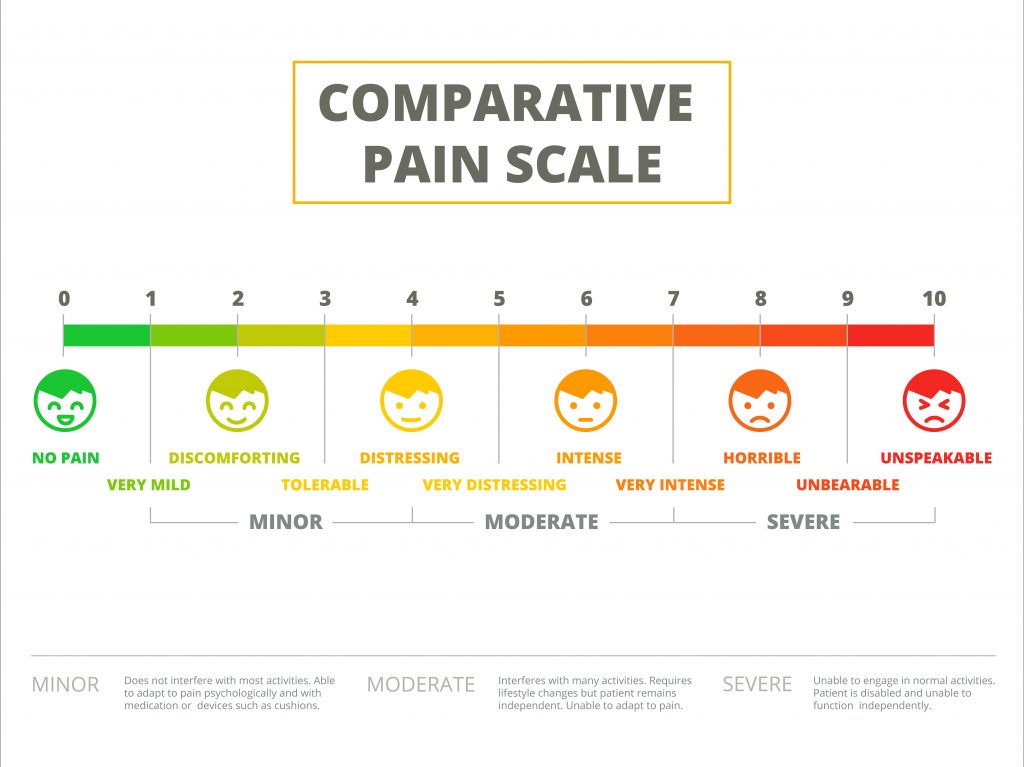
Sep 23, 2021
Paingone
How to Describe Pain Accurately to Your Doctor
Being in pain and being able to express how it feels are two different things. Many people with chronic pain struggle with being heard by the doctors, partly because they aren’t sure how to clearly explain what they are feeling. Because pain is complex and comes in many forms, it’s important to accurately convey the sensations to your doctor so they can discover the source and recommend the best treatment options.
Where is the Pain?
Locating the pain should be relatively easy – is it in your abdomen or your lower back? But once you’ve narrowed it down to a region, consider where it feels like it began. Does it seem to be widespread muscle pain, or is it focused in the joints? Is it a surface pain or felt deep inside the body?
Generally, bone pain is local and sharp but can radiate in waves along the length of the bone. Joints tend to ache only at the source, not along the length of an arm or leg. Joint pain can be more severe if when you are overactive.
Be Precise
Referring to a stiff joint or a stomachache isn’t going to help you or your doctor. Vague descriptions won’t help your physician pinpoint the source or kind of pain. Comparisons can be helpful, such as, “When I move my leg, it feels like the hip joint is locking up.” You can also use descriptive words to express the pain:
- Grinding or Crunching. If movement triggers the sensation of things grinding together or crunching, it may indicate joint deterioration.
- Snap, Crackle, and Pop. Does it feel like something releases that was caught or too tight? Does a joint feel like it is popping in and out?
- Sickening. If your pain leads to or is accompanied by nausea, vomiting, or queasiness, be sure to let your doctor know.
- Throbbing. When your pain pulses or throbs, it’s important to tell your doctor.
- Dull or Achy. A dull ache or pain can be incredibly tiring because it sometimes operates in the background but is always there. Sometimes it might flare up into a burning or stabbing sensation. Think of dull pain like the pain of a bruise.
- Burning. Does the area feel hot or like it is on fire? Burning pain is often so severe that it leaves you gasping.
- Stabbing. Let your doctor know if the pain starts suddenly and feels like someone has stabbed you with something sharp. Explain whether the sensation is periodic or constant and when it occurs.
- Radiating. Pain that travels is called radiating pain. For instance, when you have Sciatica, the pain may start in your hip but radiate down your leg when you move. Radiating pain is often, but not always, caused by nerve inflammation or damage.

Location, Location, Location
Be as precise as possible when describing pain. In some situations, it can mean the difference between life and death (explaining where abdominal pain is located, for instance. Some areas indicate appendicitis, others are something completely different). Instead of backache, pinpoint it, “the lower back, just above my hips, but close to the spine.”
How and When
Is the pain constant, or is it the result of some kind of activity? Determining how the pain started is part of the diagnostic process, so take note of how and when your pain occurs. Do you feel it when you’re lying down but not standing? Is it more severe in the morning? What triggers it?
You also need to let your doctor know how long the pain lasts when it hits. If it flares for an hour and subsides, the source is probably different than if your pain continually builds throughout the day. Anything that affects the severity and duration of your pain should be discussed with your doctor. Don’t neglect to tell them if your pain increases due to environmental factors such as cold weather, stress, or when you’re tired.
How Bad is the Pain?
Pain level is subjective. One person may describe the pain as horrible, while another person with the same pain could say it’s minimal. To get around this, some doctors use a pain scale, usually based on a scale of 1 to 10. On the scale, a 1 represents almost no pain or lack of pain. Unbearable pain ranks as a 10. Using a pain scale, you should evaluate the severity of the pain and how much it affects your life.
A Typical Pain Scale:

- 1 = Mild, occasional pain
- 2 = Annoying pain, but not all the time
- 3 = pain that’s noticeable if you aren’t otherwise occupied
- 4 = Pain that is noticeable even when occupied
- 5 = pain that’s difficult to ignore, although you can still work. Discomfort is often and noticeable.
- 6 = pain you can’t ignore
- 7 = Pain that interferes with activities, work, sleep, and relationships.
- 8 = pain that creates difficulties performing tasks and is severe enough to cause dizziness or nausea
- 9 = pain that results in passing out, inability to function, crying, or difficulty communicating pain
- 10 = Unconsciousness
The more detail you can provide when describing pain to your doctor, the more it will help them diagnose the root cause of your discomfort. Knowing what is causing your pain is the first step in finding a treatment or treatments that can help.
Is Paingone helping your patients and your practice?
Tell us your success story.
A robust retail strategy is essential to growing your practice.
You only have so many hours a week available for appointments. The fastest way to increase your bottom line is to incorporate profitable products that generate repeat business and build your reputation as a medical professional. That’s where Paingone comes in.
Contact us below to learn more about our products, wholesale pricing and how Paingone can benefit your practice.

